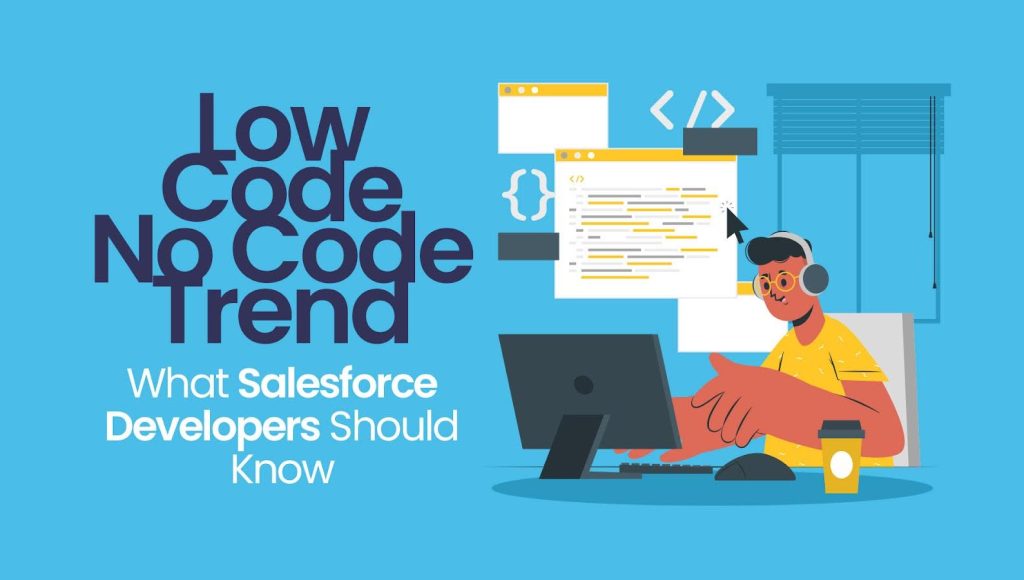Welcome, fellow Salesforce enthusiasts! If you’ve been hearing about the low-code/no-code wave and wondering how it will modify being a Salesforce developer, then this place is for you. We aim to discuss how this trend can affect or benefit your business in this blog post, and the ways to make use of this trend to your advantage.
We will discuss the implications of it, its features, benefits and the tools in the Salesforce ecosystem. All this is intended to lighten up the path in such an exciting software development evolution.
What is Low-Code and No-Code Development?
Low-code/no-code development refers to the new technique of building software applications, the process of which involves less and in some cases no coding at all. It employs visual interfaces, drag-and-drop features and pre-built components that make programming beginner-friendly. Unlike writing code for several lines, the low-code platforms give developers the ability to assemble apps by piecing together the various modules and defining parameters.
How Low-Code/No-Code Development is Revolutionizing Application Development?
Low-code/no-code development is transforming the way applications are produced and delivered by drastically lowering the time, cost, and complexity associated with traditional coding methods. The use of low-code/no-code development marks a fundamental shift in software development techniques, propelling digital transformation and redefining how applications are designed, built, and delivered.
Key Features of low-code/no-code platforms
Low-code/no-code development is transforming the way applications are produced and delivered by drastically lowering the time, cost, and complexity associated with traditional coding methods. The use of low-code/no-code development marks a fundamental shift in software development techniques, propelling digital transformation and redefining how applications are designed, built, and delivered.
1. Visual Development Environment
Low-code / no-code solutions have visual interfaces which enable users to create the applications with drag-and-drop components and lessen the amount of manual programming needed.
2. Pre-built Templates and Components
These platforms boast libraries of pre-made templates, modules and components which developers can use to shorten development time and incorporate into their applications.
3. Cross-Platform Compatibility
Through these platforms, different devices and different operating systems can interact smoothly with each other. On top of that, they are well-adapted to be used by laypeople.
4. Integration Capabilities
Such platforms tend to support built-in integration with third-party services, APIs, and databases, which helps users connect their programs with external systems without excess coding effort.
5. Workflow Automation
LC/NC platforms implement a set of tools enabling the platform users to automate their work processes and tasks, as a result, this brings about a rise in performance and productivity.
6. Collaboration Features
The best news is that these platforms help teams collaborate by using the tools that are always available to them as they have been created to complete any job together, ensuring features for version control and commenting are widely used.
7. Built-in Security
Low-code/no-code platforms emphasize security with features such as user authentication, data encryption, and full compliance with industry standards as well as rules and regulations.
8. Real-time Testing and Deployment
Developers can rapidly test their apps in real time and deploy updates at once, thereby optimizing the software life cycle by shortening the time-to-market.
Benefits of low-code/no-code platforms
1. Accelerated Development
Low-code no-code platforms lead to simplified development that makes applications come to the market even faster.
2. Pre-built Templates and Components
These platforms boast libraries of pre-made templates, modules and components which developers can use to shorten development time and incorporate into their applications.
3. Cross-Platform Compatibility
Through these platforms, different devices and different operating systems can interact smoothly with each other. On top of that, they are well-adapted to be used by laypeople.
4. Increased Productivity
With intuitive interfaces and pre-built components, developers can focus on high-level tasks, boosting productivity.
5. Flexibility and Adaptability
A low-code/no-code application platform helps reduce difficulty in customizing and adapting to the dynamic conditions of the business.
6. Improved Collaboration
There is better coordination and more structured cooperation between the IT and business units, which will ensure that there is no room for misalignment in the applications.
7. Scalability
Applications that operate on low-code/no-code platforms scale well and can easily cover a growing number of users or improve functionality.
8. Enhanced Security:
Security measures such as inbuilt security features and compliance obligations protect your data and create compliance with the law.
Low-Code/No-Code Tools Available within the Salesforce Ecosystem
In the Salesforce ecosystem, a combination of those low-code/no-code tools makes it possible for users to create apps and automate them without much knowledge. Using Salesforce App Builder, customers can build their UIs feasibly by using simple drag-and-drop actions, thus leading to decreasing code dependence by a huge extent. Users operate predefined tools called “Flow” to begin their process of creating automation flows and procedures without writing code. However, Salesforce OmniStudio equips developers with the ability to build digital uniformity by combining the powers of low coding development, while customization and automation play a vital part in this process.
The OmniStudio seamlessly combines tools like First Process Builder, Second Flow Builder and Third Lighting App Builder to allow developers to design complete solutions such as integrating custom applications, updating existing ones or creating brand new ones. It provides the capability of the creation and modification of the software at a faster pace and also in accordance with the different types of requirements of the business. Moreover, OmniStudio is regarded as a digital amalgamation of platforms effortlessly building, deploying, and maintaining applications without any compromise on consistency and efficiency.
Einstein, the AI by Salesforce, intelligently blends AI and low-code, performing intelligent processes, automating boring operations, and interconnecting data easily within the powerful Salesforce ecosystem. All in all, the use and implementation of the technologies are now revolutionizing existing systems of application development, and empowering users from novice to expert to influence and promote the growth of the company easily.
Implications for Salesforce Developers
The low-code/no-code trend in Salesforce development requires a shift in the role of the Salesforce developer from a sole coder to a facilitator and consultant. This involves a focus on cooperation, communication, and recognition of organizational processes so that solutions can be tailored to ensure they are targeted at those goals. Low-code/no-code tools can help in application development with high speed, shrinking the duration of development and the encouragement of non-technical users to become involved in solution creation.
They enable developers to focus on complex areas of system integration and design architecture while developing sophisticated solutions specific to a particular client. Despite the fears about whether coding jobs will be threatened or not, these tools promote the growth of innovation, creativity and specialized job skills.
Embracing the Low-Code/No-Code Paradigm
The low-code/no-code paradigm is an opportunity for developers to innovate, streamline development processes, and solve higher-level business problems. It allows for increased efficiency and productivity, enabling quick prototypes, automation of repetitive tasks, and user participation.
Integrating these tools alongside traditional coding practices accelerates application delivery and delivers more value to organizations. Collaborating with citizen developers, who can contribute independently while maintaining control, is essential for harnessing the full potential of these tools. This approach fosters innovation, accelerates time-to-market, and strengthens IT-business relationships.
Upskilling for the Future
Continuous learning and upskilling are key aspects of the low/no-code development age when it comes to staying relevant and competitive. Adopt circumstances which will help you acquire additional skills and adapt to new technologies. Identify areas of specialisation, advanced Salesforce configuration, data modelling, and API integrations, to differentiate yourself from other consultants as an expert/specialist.
Engage in continuous education about the recent technologies and trends in the Salesforce environment to keep a competitive edge among job seekers. Staying ahead of the curve positions you as a knowledgeable and adaptable professional ready to thrive in the future of Salesforce development.
Conclusion
In the low code/no code development which is becoming popular these days, continual learning and upskilling are extremely important for the salesforce developers to remain competitive. Applying this new paradigm as an opportunity rather than a threat enables developers to innovate, build applications faster, and fix complex business issues in no time.
Developers should aim at implementing these tools in their workflow, establishing ties with citizen developers, and staying up-to-date on technology inventions. This way, they will portray themselves as talented experts ready to face the future of Salesforce development. Contact us for more details on implementation.

